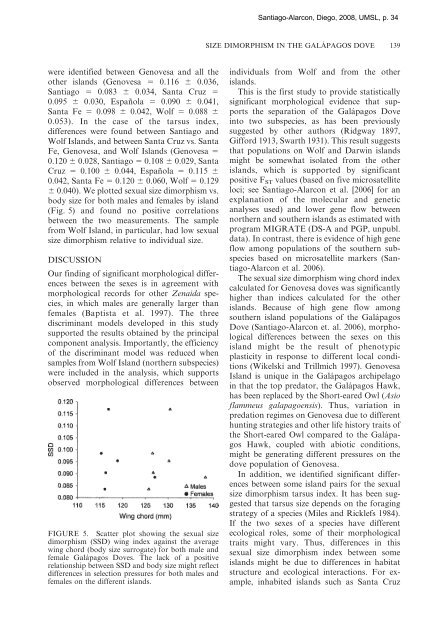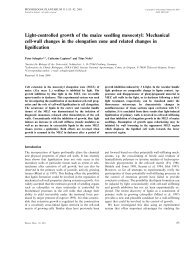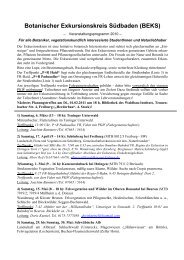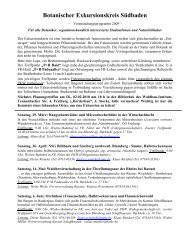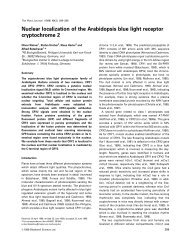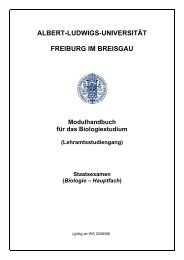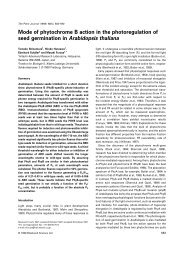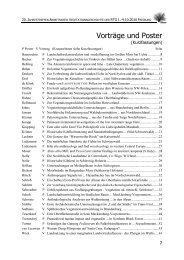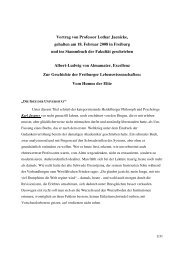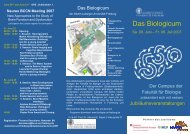SEXUAL SIZE DIMORPHISM AND MORPHOLOGICAL EVIDENCE ...
SEXUAL SIZE DIMORPHISM AND MORPHOLOGICAL EVIDENCE ...
SEXUAL SIZE DIMORPHISM AND MORPHOLOGICAL EVIDENCE ...
Create successful ePaper yourself
Turn your PDF publications into a flip-book with our unique Google optimized e-Paper software.
were identified between Genovesa and all the<br />
other islands (Genovesa 5 0.116 6 0.036,<br />
Santiago 5 0.083 6 0.034, Santa Cruz 5<br />
0.095 6 0.030, Española 5 0.090 6 0.041,<br />
Santa Fe 5 0.098 6 0.042, Wolf 5 0.088 6<br />
0.053). In the case of the tarsus index,<br />
differences were found between Santiago and<br />
Wolf Islands, and between Santa Cruz vs. Santa<br />
Fe, Genovesa, and Wolf Islands (Genovesa 5<br />
0.120 6 0.028, Santiago 5 0.108 6 0.029, Santa<br />
Cruz 5 0.100 6 0.044, Española 5 0.115 6<br />
0.042, Santa Fe 5 0.120 6 0.060, Wolf 5 0.129<br />
6 0.040). We plotted sexual size dimorphism vs.<br />
body size for both males and females by island<br />
(Fig. 5) and found no positive correlations<br />
between the two measurements. The sample<br />
from Wolf Island, in particular, had low sexual<br />
size dimorphism relative to individual size.<br />
DISCUSSION<br />
Our finding of significant morphological differences<br />
between the sexes is in agreement with<br />
morphological records for other Zenaida species,<br />
in which males are generally larger than<br />
females (Baptista et al. 1997). The three<br />
discriminant models developed in this study<br />
supported the results obtained by the principal<br />
component analysis. Importantly, the efficiency<br />
of the discriminant model was reduced when<br />
samples from Wolf Island (northern subspecies)<br />
were included in the analysis, which supports<br />
observed morphological differences between<br />
FIGURE 5. Scatter plot showing the sexual size<br />
dimorphism (SSD) wing index against the average<br />
wing chord (body size surrogate) for both male and<br />
female Galápagos Doves. The lack of a positive<br />
relationship between SSD and body size might reflect<br />
differences in selection pressures for both males and<br />
females on the different islands.<br />
Santiago-Alarcon, Diego, 2008, UMSL, p. 34<br />
<strong>SIZE</strong> <strong>DIMORPHISM</strong> IN THE GALÁPAGOS DOVE 139<br />
individuals from Wolf and from the other<br />
islands.<br />
This is the first study to provide statistically<br />
significant morphological evidence that supports<br />
the separation of the Galápagos Dove<br />
into two subspecies, as has been previously<br />
suggested by other authors (Ridgway 1897,<br />
Gifford 1913, Swarth 1931). This result suggests<br />
that populations on Wolf and Darwin islands<br />
might be somewhat isolated from the other<br />
islands, which is supported by significant<br />
positive F ST values (based on five microsatellite<br />
loci; see Santiago-Alarcon et al. [2006] for an<br />
explanation of the molecular and genetic<br />
analyses used) and lower gene flow between<br />
northern and southern islands as estimated with<br />
program MIGRATE (DS-A and PGP, unpubl.<br />
data). In contrast, there is evidence of high gene<br />
flow among populations of the southern subspecies<br />
based on microsatellite markers (Santiago-Alarcon<br />
et al. 2006).<br />
The sexual size dimorphism wing chord index<br />
calculated for Genovesa doves was significantly<br />
higher than indices calculated for the other<br />
islands. Because of high gene flow among<br />
southern island populations of the Galápagos<br />
Dove (Santiago-Alarcon et. al. 2006), morphological<br />
differences between the sexes on this<br />
island might be the result of phenotypic<br />
plasticity in response to different local conditions<br />
(Wikelski and Trillmich 1997). Genovesa<br />
Island is unique in the Galápagos archipelago<br />
in that the top predator, the Galápagos Hawk,<br />
has been replaced by the Short-eared Owl (Asio<br />
flammeus galapagoensis). Thus, variation in<br />
predation regimes on Genovesa due to different<br />
hunting strategies and other life history traits of<br />
the Short-eared Owl compared to the Galápagos<br />
Hawk, coupled with abiotic conditions,<br />
might be generating different pressures on the<br />
dove population of Genovesa.<br />
In addition, we identified significant differences<br />
between some island pairs for the sexual<br />
size dimorphism tarsus index. It has been suggested<br />
that tarsus size depends on the foraging<br />
strategy of a species (Miles and Ricklefs 1984).<br />
If the two sexes of a species have different<br />
ecological roles, some of their morphological<br />
traits might vary. Thus, differences in this<br />
sexual size dimorphism index between some<br />
islands might be due to differences in habitat<br />
structure and ecological interactions. For example,<br />
inhabited islands such as Santa Cruz


